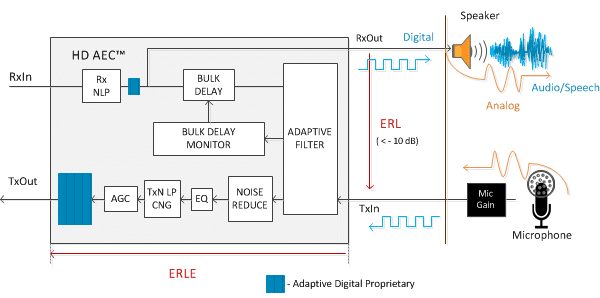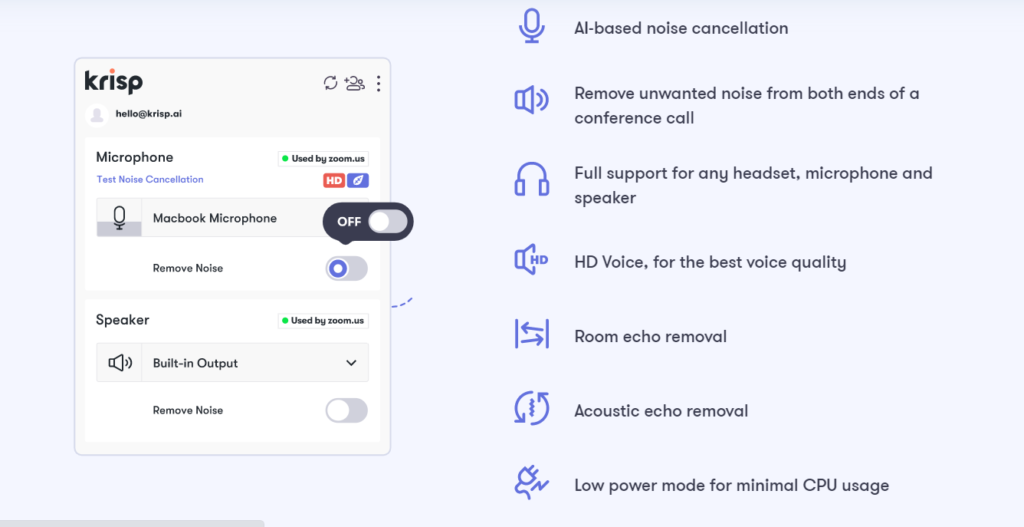

The frame size in that case must be a multiple of the partition (block) length, thereby greatly reducing the latency for long impulse responses. Latency may be reduced by using partitioned FDAF, which partitions the filter impulse response into shorter segments, applies FDAF to each segment, and then combines the intermediate results. This can be unacceptable for many real-world applications. Based on our years of experience in this field. In some cases, the resulting howling effect will generate a deafening noise. Once echo appears in a phone call and you start hearing yourself, most probably the remaining duration of the call will be very short. Traditional FDAF is numerically more efficient than time-domain adaptive filtering for long impulse responses, but it imposes high latency, because the input frame size must be a multiple of the specified filter length. Echo is one of the most disturbing problems in telecommunication. Without such detection schemes, the performance of the system with the larger step size is not as good as the former, as can be seen from the ERLE plots. To deal with this performance difficulty, acoustic echo cancelers include a detection scheme to tell when near-end speech is present and lower the step size value over these periods. With a larger step size, the ERLE performance is not as good due to the misadjustment introduced by the near-end speech. % Plot near-end, far-end, microphone, AEC output and ERLEĪECScope2(nearSpeech, micSignal, e, erledB) % Send the speech samples to the output audio deviceĮrle = diffAverager((e-nearSpeech).^2)./ farEchoAverager(farSpeechEcho.^2) % Stream processing loop - adaptive filter step size = 0.04 while(~isDone(nearSpeechSrc)) From the plot, observe that you achieved about a 35 dB ERLE at the end of the convergence period.ĪECScope2.Title = 'Output of Acoustic Echo Canceller mu=0.04' ĪECScope2.Title = 'Echo Return Loss Enhancement mu=0.04'
ACOUSTIC ECHO CANCELLATION SOFTWARE SOFTWARE
Since you have access to both the near-end and far-end speech signals, you can compute the echo return loss enhancement (ERLE), which is a smoothed measure of the amount (in dB) that the echo has been attenuated. VOCAL’s embedded software libraries include a complete range of ETSI / ITU / IEEE compliant algorithms as well as many other standard and proprietary algorithms. % Far-end speech signal echoed by the roomįarSpeechEchoSrc.SamplesPerFrame = frameSize NearSpeechSrc.SamplesPerFrame = frameSize įarSpeechSrc.SamplesPerFrame = frameSize 'BufferLength', length(x)) ĪECScope1.Title = 'Near-End Speech Signal' ĪECScope1.Title = 'Output of Acoustic Echo Canceller mu=0.025' ĪECScope1.Title = 'Echo Return Loss Enhancement mu=0.025' 'TimeSpan', 35, 'TimeSpanOverrunAction', 'Scroll'. 'LayoutDimensions',, 'TimeSpanSource', 'Property'. Audio Ducking, Active Noise and Acoustic Echo Cancellation using TMS320C5535 eZdsp USB Stick Development Kit is an application system designed for live audio broadcasting and recording purposes. 'Method', 'Unconstrained FDAF') ĪECScope1 = timescope(4, fs.

This allows full-bandwidth, low latency, direct microphone signals to be mixed and processed for local sound reinforcement purposes.% Construct the Frequency-Domain Adaptive FilterĮchoCanceller = dsp.FrequencyDomainAdaptiveFilter( 'Length', 2048. The Soundweb London AEC Input Cards also offer a direct microphone feed for local sound reinforcement.
ACOUSTIC ECHO CANCELLATION SOFTWARE PC
Other options here may also help reduce background noisefor example, on the PC we tested this on, there was an Acoustic Echo Cancellation option that would help reduce echo caused by speakers if you’re not wearing headphones. Non-Linear Processing (NLP) dynamically adjusts to minimize echo caused by under or over-cancellation. If there’s a Noise Suppression or Noise Cancellation option, enable it. This stops the noise from being amplified. Noise Cancellation (NC) removes steady state noise (such as from a projector fan or air conditioning device) from the signal path. They offer four independent channels of AEC which can be freely configured in software and individual AEC references allowing users to provide a solution for multiple spaces using a single device.Īutomatic Gain Control (AGC) ensures that the inputs of the microphones are set at the optimum level. Like the Soundweb London Analog Input Cards, the Soundweb London AEC Input Cards offer Phantom Power, configurable per channel and software controlled analog gain in 6dB steps from 0dB to 48dB. These AEC Input Cards enable Soundweb London devices to cancel acoustic echo arising when sound from a loudspeaker enters a microphone in the same room in a conference application. CHAPTER 3 THE ECHO CANCELLATION ALGORITHM 21 3.1 Basic Echo Canceller 21 3.2 Components of Acoustic Echo Canceller (AEC) 24 3.3 Adaptive Filtering 25 3.3.1 Least Mean Square (LMS) Algorithm 26 3.3.1.1 Generic LMS Algorithm 27 3.3.

The Soundweb London Acoustic Echo Cancellation (AEC) Input Cards are designed to populate any of the four card slots on Soundweb London BLU-800, BLU-805, BLU-806, BLU-320, BLU-325, BLU-326, BLU-160 and BLU-120 devices.


 0 kommentar(er)
0 kommentar(er)
